Everything You Need To Know About Support Structures In 3D Printing
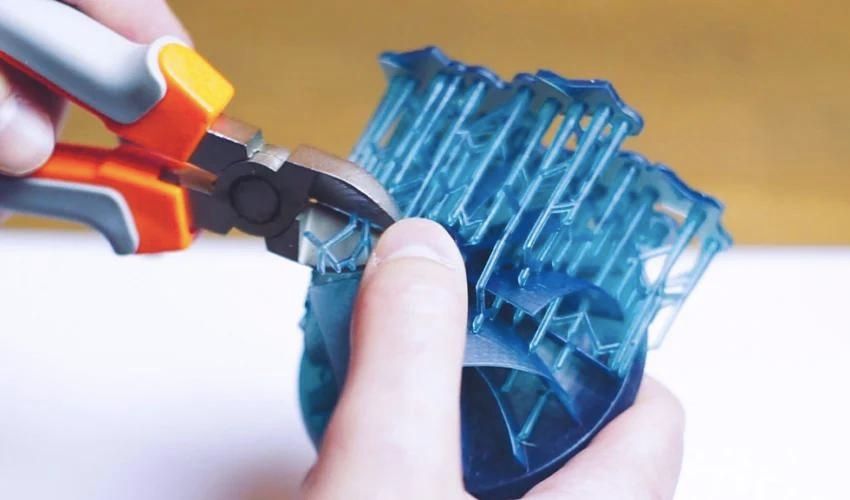
One of the features of additive manufacturing is that it offers great design freedom to create complex and truly impressive parts. However, creating perfect models can require intermediate steps, such as the use of supports. In 3D printing, supports, as the name suggests, are structures that support the unsupported areas of a part. Although at first glance it seems like a simple concept, it can be difficult, especially when it comes to configuring 3D printing supports for your part. Users may have questions such as when they are really necessary, how they can be removed, and what disadvantages their use can have. To answer these questions, we took a deep dive into the effective use of supports in additive manufacturing.
The Choice of Support Structures Depends On the Technology
If you are considering using these supports, the first thing to keep in mind is that depending on the 3D printing technology you use and the complexity of your design, the type of support and function will vary. In FDM 3D printing, for example, there are two general rules you need to know for support structures: the 45-degree rule and the 5-millimeter rule. The first refers to the 3D printer’s horizontal offset between successive layers. So if an overhang of the part tilts at an angle less than 45 degrees from vertical, you can print that overhang without supports. However, if the angle is greater, the machine will not stack the layers properly and the overhang will require support structures. On the other hand, the 5 mm rule states that supports are not required if a bridge (distance between two parallel points on the part) is less than 5 mm, but if it is larger than that then printing problems occur. To connect the two parallel dots without supports, the printer uses a technique called bridging. In this method, the hot material is stretched over short distances to make the connection with minimal sag.
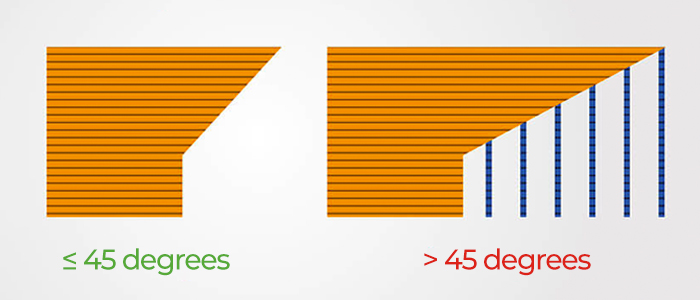
The 45 degree rule applies to 3D extrusion printing.
In contrast, resin 3D printing using processes such as SLA or DLP to produce the final part by photopolymerizing the liquid material using a light source. This technology is one of the most precise, capable of producing the smallest and most complex objects with exact details. It is characterized by the fact that it works in the opposite direction than extrusion, thus the pressure shell is on top rather than the bottom. For this reason, and to ensure that the prints adhere to the platform, these machines almost always require supports. These structures look like thin columns with only a few small points of contact with the model to save on both material and manufacturing time. In this case, the appropriate software can calculate the number of supports, their position, where they touch the part; these factors depend on the complexity of the part in question. With proper post-processing, 3D printing resin with support structures should not affect the quality of the finished part.
In additive manufacturing, there are also a number of technologies that rely on a powder bed to produce the parts. This group includes selective laser sintering (SLS), direct metal laser sintering (DMLS), electron beam melting (EBM) or binder jetting. Generally, for polymer laser processes, it is not necessary to have supports, as the powder itself serves as the support for each layer. While this allows greater freedom in part design, it often increases the cost and time required for printing.
That being said, while with selective laser sintering or multi jet fusion, supports are not necessary, working with metal technologies is much complex. Rather, they are often necessary but the term “supports” refers rather to the anchoring the parts to the printing table. Robert Chiari, sales manager at DMG MORI, explains, “Because of the stresses in metals, especially high-strength materials like titanium, the material can break away from the structure below the standard. So the support is actually a plate that serves to anchor the part during construction.” Another function of the powder surrounding the parts (in addition to acting as a support) is to dissipate heat during the manufacturing process so as not to compromise the integrity of the part or material, a critical consideration especially when working with metal.
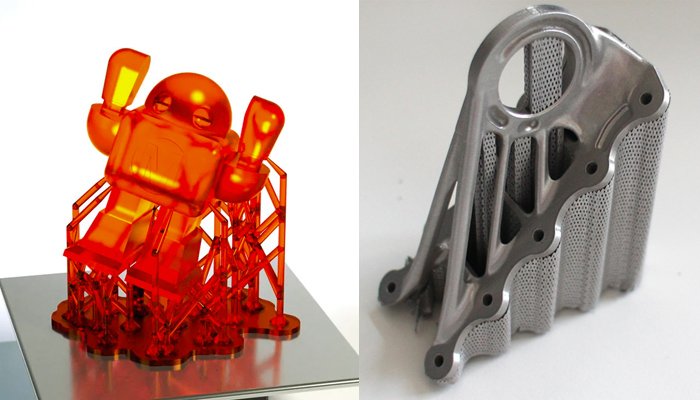
Left: a 3D part printed with resin. On the right, a “cockpit support” of the Airbus A350 XWB.
In material jetting 3D printing, liquid photopolymers are applied to the printing plate. Layer by layer, the material is instantly cured by an ultraviolet light source. In this case, 3D printers require supports when parts of the product protrude, regardless of the angle or slope of the previous layer. These supports can be removed by post-processing steps such as ultrasonic baths and sand or water blasting. Since the use of supports in this technology does not affect the finishing of the parts, it is really difficult to see where the supports were used after post-processing, making the part surface smoother than in cases where the removal is clear.
Types of Supports in 3D Printing
Although the support structures have a similar function in any technology, there are different types depending on the design or composition. In terms of design, the most popular are the so-called lattice girders. These structures are often used to create columns that hold parts in place, which is very useful for parts with steep overhangs. They are popular because of their ease and speed of fabrication, as well as their compatibility with most printing processes. The only drawback is that they can be difficult to remove in some cases and can even leave marks on parts.
There are also tree supports that are characterized by starting with “trunk” structures and developing into fine branches when they reach the printed model. This is very useful for supporting selected parts of the part that are cantilevered but not too vertical. Users often employ linear supports, which are somewhat similar to tree supports. They consist of vertical supports in contact with the entire cantilevered member or bridge. While they ensure a correct impression of the part, they are more difficult to remove and can damage the surface of the model.
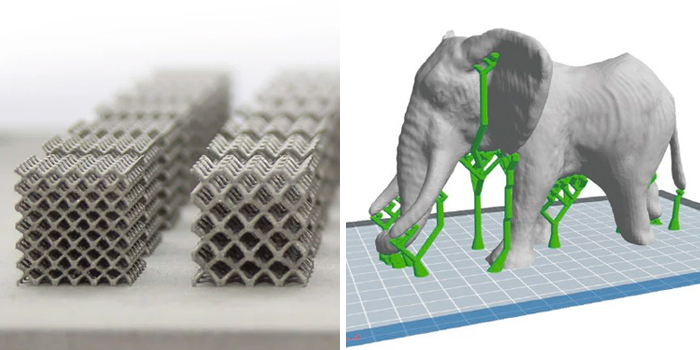
Links: eine Gitterstruktur. Rechts: Baumstützen.
Finally, regarding the material, soluble support materials also exist. You can produce these structures with dual extrusion 3D printers and remove them by diluting them in water or in a solvent with more complex components. The most well-known soluble materials include PVA or HIPS, but there are also more advanced ones, such as AquaSys 180 (developed by Infinite Material Solutions), which is compatible with high-performance materials.
How to Optimize the Use of Supports?
When using 3D printing to manufacture parts, it is important to understand the function of the supports and the advantages they offer during the manufacturing process. In addition to the advantages already mentioned, such as freedom of design and certainty of the final quality of the models, the use of these structures also brings a number of disadvantages. The first one concerns the removal of these supports, since without proper post-treatment, the aesthetics of the final product could be compromised. Injection molding is an exception to this rule.
However, the more supports configured on the slicer, the more complex a design can be for certain additive manufacturing technologies. This is closely related to the obvious amount of material required to manufacture the supports. The amount of material required for the part can be optimized by considering various aspects such as alignment and accuracy, as well as other design and manufacturing factors. By properly adjusting these parameters, we can achieve not only a reduction in printing time and material, but also in final cost and lead times.
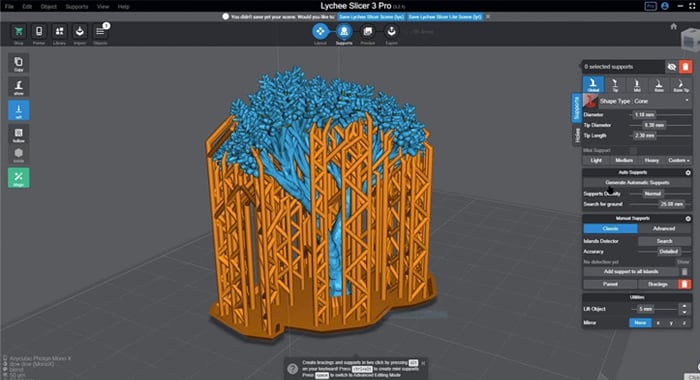
Photo Credits: Lychee Slicer
In summary, the use of supports in additive manufacturing is necessary when dealing with complex parts or models with many overhangs. Nevertheless, it is important to know the specifics of each technology in order to get the most out of these support structures and obtain high-quality final parts.
What do you think of this guide on support structures for 3D printing? Let us know in a comment below or on our Facebook, Twitter and LinkedIn pages! Sign up for our free weekly Newsletter here, the latest 3D printing news straight to your inbox!
*Cover Photo Credits: Hubs






